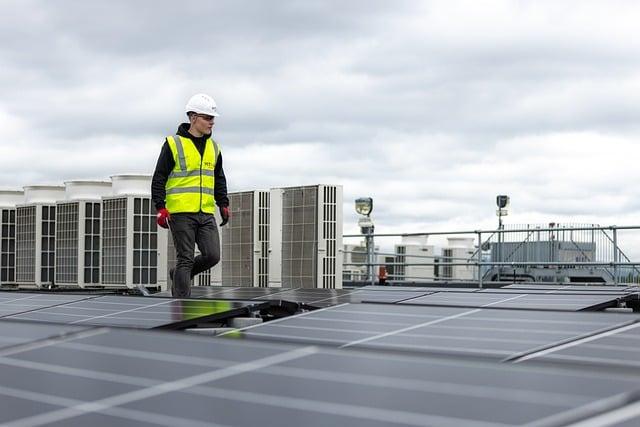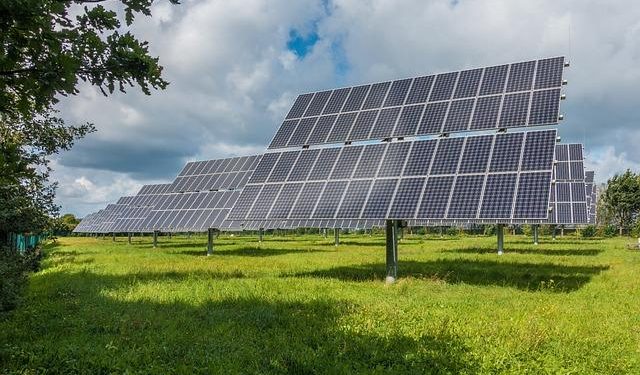In the ever-evolving landscape of global energy, the sun is rising not just on the horizon but also as a beacon of economic opportunity. Solar energy, once a niche alternative, has swiftly ascended to become a cornerstone of sustainable development and economic growth. This luminous transformation is powered by a convergence of technological innovation, policy shifts, and an increasing awareness of environmental stewardship. As countries around the world harness the abundant power of the sun, they are not only reducing carbon footprints but also unlocking new economic pathways. This article delves into the dynamic trends in solar energy that are fueling economic expansion, exploring how this renewable resource is reshaping industries, creating jobs, and fostering a resilient future. Whether it’s through cutting-edge photovoltaic technologies or innovative financing models, solar energy is illuminating a path towards prosperity, one ray at a time.
Harnessing the Suns Potential: How Solar Innovations Propel Economic Expansion
In recent years, the transformative power of solar energy has surged beyond mere environmental benefits, catalyzing significant economic growth. This expansion is fueled by a series of innovative trends that have reshaped the landscape of energy production and consumption. Advanced photovoltaic technologies have drastically increased the efficiency of solar panels, reducing costs and making solar energy more accessible to businesses and households. Moreover, solar storage solutions have evolved, enabling the retention and distribution of energy during peak demand times, thereby stabilizing energy markets and fostering economic resilience.
Simultaneously, the rise of solar-powered infrastructure projects has opened up new avenues for economic development. From solar farms that provide sustainable power to entire communities, to solar-integrated buildings that reduce urban carbon footprints, the potential for job creation and economic diversification is immense. The trend towards decentralized energy systems further democratizes energy access, empowering local economies and driving innovation. As these advancements continue, they promise to not only enhance energy security but also propel industries forward, creating a ripple effect of prosperity and sustainability.
- Advanced photovoltaic technologies
- Solar storage solutions
- Solar-powered infrastructure projects
- Decentralized energy systems
The Role of Technological Advancements in Lowering Solar Energy Costs
In recent years, remarkable strides in technology have significantly reduced the cost of harnessing solar energy, making it more accessible to a broader audience. Innovations in photovoltaic (PV) technology have led to the creation of more efficient solar cells, which are capable of converting sunlight into electricity at a much higher rate than previous models. The introduction of thin-film solar panels and bifacial modules has further enhanced energy capture, allowing solar installations to generate more power even in low-light conditions. Additionally, the use of advanced materials like perovskites has shown potential in reducing manufacturing costs while maintaining high efficiency.
Automation and AI-driven solutions have also played a crucial role in cutting down operational costs. Smart algorithms optimize the angle and positioning of solar panels, maximizing their exposure to sunlight. Moreover, the integration of IoT devices in solar farms has streamlined maintenance processes, reducing downtime and operational inefficiencies. Energy storage technologies, such as advanced lithium-ion batteries and emerging solid-state batteries, have improved the ability to store and dispatch solar energy, ensuring a more reliable and consistent power supply. These technological breakthroughs collectively contribute to a sustainable reduction in solar energy costs, fostering economic growth and encouraging a transition towards cleaner energy sources.

Strategic Policy Recommendations for Maximizing Solar Investment Returns
To ensure that solar investments yield optimal returns, stakeholders should consider a multi-faceted approach that aligns with both current market dynamics and emerging trends. Diversification of investment portfolios is key. By investing in a variety of solar technologies, such as photovoltaic systems, solar thermal, and hybrid solutions, investors can mitigate risks associated with market volatility and technological obsolescence.
- Focus on regions with favorable regulatory environments and strong solar resources.
- Leverage government incentives and tax credits to enhance financial performance.
- Invest in advanced energy storage solutions to complement solar installations and ensure reliability.
Additionally, fostering partnerships with innovative startups and established solar companies can lead to synergies that boost technological advancements and cost efficiencies. Utilizing data analytics and AI to optimize energy production and predict maintenance needs will further enhance the long-term profitability of solar assets. By adopting these strategies, investors can not only maximize returns but also contribute to a sustainable energy future.

Empowering Communities: Solar Energy as a Catalyst for Local Economic Development
In recent years, the landscape of local economies has been transformed by the rise of solar energy, a renewable powerhouse that is not only sustainable but also economically advantageous. Communities worldwide are increasingly harnessing the sun’s power to drive local economic growth. This shift is supported by several key trends:
- Job Creation: The solar industry is a significant source of new jobs, ranging from installation to maintenance and engineering. As communities adopt solar technology, they experience a surge in employment opportunities, often providing stable and well-paying jobs.
- Energy Independence: By investing in solar infrastructure, communities reduce their reliance on external energy sources. This not only leads to cost savings but also ensures energy security, allowing local economies to thrive even in times of global energy uncertainty.
- Local Investment: The move towards solar energy encourages local investment. Small businesses and homeowners are increasingly investing in solar installations, leading to a boost in the local economy as money circulates within the community rather than flowing out.
As these trends continue to evolve, solar energy stands as a beacon of economic revitalization, offering a sustainable path to prosperity for communities around the globe.
In Conclusion
As we stand on the brink of a new energy era, solar power emerges not just as a beacon of sustainability, but as a formidable engine propelling economic growth. The trends we observe today are more than fleeting glimpses of a cleaner future; they are the building blocks of a robust economic landscape where innovation, efficiency, and environmental stewardship converge. As the sun sets on traditional energy paradigms, it rises again, illuminating a path where economies can thrive in harmony with nature. The journey of solar energy is one of transformation—of markets, communities, and mindsets. And while the road ahead may be paved with challenges, it is also lined with opportunities waiting to be harnessed by those ready to embrace the power of the sun. As we continue to explore these solar-driven horizons, one thing is clear: the future is bright, and it is powered by solar energy.

































